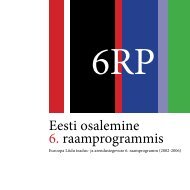Reactive Systems: Modelling, Specification and Verification - Cs.ioc.ee
Reactive Systems: Modelling, Specification and Verification - Cs.ioc.ee
Reactive Systems: Modelling, Specification and Verification - Cs.ioc.ee
Create successful ePaper yourself
Turn your PDF publications into a flip-book with our unique Google optimized e-Paper software.
6.7. MIXING LARGEST AND LEAST FIXED POINTS 153<br />
• Di is a declaration mapping the variables in the set Xi to formulae in HML<br />
with recursion that may use variables in the set <br />
1≤j≤i Xj,<br />
• mi = max or mi = min, <strong>and</strong><br />
• mi = mi+1.<br />
We refer to (Di, Xi, mi) as the ith block of E <strong>and</strong> say that it is a maximal block if<br />
mi = max <strong>and</strong> a minimal block otherwise. <br />
Observe that our earlier specification of the formula P os(LivelockNow) is given<br />
in terms of a 2-nested mutually recursive equational system. In fact, take X1 =<br />
{LivelockNow} <strong>and</strong> X2 = {P os(LivelockNow)}. You can now easily check that<br />
the constraints in the above definition are met. On the other h<strong>and</strong>, the mixed equational<br />
system<br />
X max<br />
= 〈a〉Y<br />
Y min<br />
= 〈b〉X<br />
does not m<strong>ee</strong>t these requirements because the variables X <strong>and</strong> Y are both defined<br />
in mutually recursive fashion, <strong>and</strong> their definitions refer to different types of fixed<br />
points. If we allow fixed points to be mixed completely fr<strong>ee</strong>ly we obtain the modal<br />
µ-calculus (Kozen, 1983), which was mentioned in Section 6.1. In this book we<br />
shall however not allow a full fr<strong>ee</strong>dom in mixing fixed points in declarations but restrict<br />
ourselves to systems of equations satisfying the constraints in Definition 6.2.<br />
Note that employing the approach described above using our running example in<br />
this section, such systems of equations have a unique solution, obtained by solving<br />
the first block <strong>and</strong> then proc<strong>ee</strong>ding with the others using the solutions already<br />
obtained for the preceding blocks.<br />
Finally if F is a Hennessy-Milner formula defined over a set of variables Y =<br />
{Y1, . . . , Yk} that are declared by an n-nested mutually recursive equational system<br />
E, then [F ] is well-defined <strong>and</strong> can be expressed by<br />
[F ] = OF ([Y1 ], . . . , [Yk ]) , (6.17)<br />
where [Y1 ], . . . , [Yk ] are the sets of states satisfying the recursively defined formulae<br />
associated with the variables Y1, . . . , Yk.<br />
Exercise 6.18 Consider the labelled transition system in Exercise 6.17. Use equation<br />
(6.17) to compute the set of states satisfying the formula<br />
F = 〈Act〉P os(LivelockNow) .
















